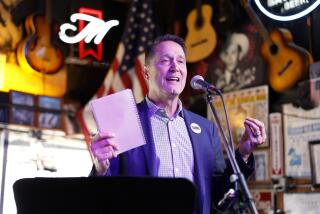Sampling: A Creative Tool or License to Steal? : The Technology
- Share via
What exactly is sampling?
“A sample is a digital recording of a sound, ‘an event,’ ” explained Barry Rudolph, a Los Angeles producer/recording engineer who writes for various music publications on technical aspects of the industry. “That event--for example, hitting a snare drum--is held in memory just like computer data.”
The sampler is a digital recorder that records sounds onto computer discs. But recording a sample isn’t as simple as punching the record button on a regular tape recorder. The sampler must have the sound come through a power source like a mixing console; someone can’t just sling a sampler over his or her shoulder, plug in a mike and record the sounds of the real world.
For optimum sound quality, the pieces of old songs that are commonly used as samples should be recorded from CD on a DAT (Digital Audio Tape) recorder, played back in the studio and recorded by the sampler there.
A sampler isn’t like a regular recorder in another important respect--it records digital information , not the sound itself. Someone can record music on one cassette recorder, pop the cassette tape into a different recorder and have the music play back immediately, but sampling doesn’t work that way.
“The only sound a sampler will make,” said Mike Leiner of West L.A. Music, “is if you drop it on the floor.”
The information contained on the sample remains dormant until it is plugged into the array of hi-tech studio equipment that has revolutionized recording studios since the advent of the digital era 10 years ago. The key element is the MIDI (Musical Instrument Digital Interface) system, which connects those instruments to one another and to the computers and software systems needed to “map out” the samples.
One of these instruments is the sequencer, which functions as something of a traffic cop in the mapping-out process. The musician uses the sequencer to assign the various sampled sounds to various keys or sections of a keyboard instrument. Then the sounds can be played back, altered in whatever ways the musician or producer desires and recorded on to a master tape or direct-to-disc.
“The sample is in a digital code and it can be manipulated just like any data,” said Rudolph. “You can shorten or lengthen it, change the pitch and tonal characteristics, add or subtract sounds to it and replay it either like a keyboard synthesizer or have your computer sequencer play it.”
Sampling doesn’t just involve recording pieces of old songs. Samples can be taken of a piece of dialogue from a TV program, a political speech, the crack of a baseball bat or a car braking at a stoplight. Sound-effects libraries in the motion picture industry are now increasingly composed of samples. The basic sounds found on the drum machines so prevalent in contemporary pop are samples.
In studio session work, a complex backing vocal part can be recorded once, sampled and then inserted at the appropriate points later in the song. The length of an individual sample is in direct proportion to how much memory the sampler has and the bandwidth (the frequency) at which the sound is being sampled. It’s highly variable, but musicians or producers generally can’t sample for any great amount of time--only 12 seconds of stereo sound at the currently accepted industry standard--unless the amount of memory contained in the sampler has been augmented.
That’s why bass and drums--rather than the more complex sounds of a lead guitar or saxophone--are the easiest instruments to sample. Despite the limited time available on each disc, drum patterns and bass lines are frequently created by a technique known as “looping”--taking one segment of a sample, joining the beginning of the phrase to the end and programming it to seamlessly repeat itself. It’s impossible for someone to, say, record a few bars of Carlos Santana’s guitar and be able to construct a reasonable facsimile of a Santana solo from that raw data. But the recorded drum sound of Phil Collins (a particularly popular sample a few years ago) or Led Zeppelin’s John Bonham could become part of any musician’s arsenal.
“In terms of the sound palette that’s available to you as a keyboard player, it opens up a tremendous spectrum,” acknowledged Jeff Lorber, a keyboardist who is frequently called on to add musical tracks for dance remixes. Two briefcase-size equipment cases jammed with computer disks comprised his personal, portable library of samples at a recent remix session for Cheryl Lynn’s “Every Time I Try to Say Goodbye.”
In the control room at Larrabee Sound Studio in West Hollywood, Lorber’s fingers dexterously danced across the control keys of his Emulator II sampler as he recorded eight snippets of Lynn’s vocals from the master tape. The title phrase of the song was one selection, but Lorber was searching for phrases that showed off the nuances and character in Lynn’s voice--like a low, throaty growl or the “Hey” and “Oh, no” ad libs that brought Aretha Franklin to mind.
Almost immediately, Lorber assigned each sample to a key on one of his keyboard instruments--from then on, that particular vocal part would play whenever he pressed that key. He could affect the sound by the force and/or rhythm with which he touched the key or physically change the sound by redrawing the frequency wave with a light pencil on a computer screen.
Now re-mix producer Keith Cohen and Lorber were armed with the option to strategically insert--in industry parlance, “fly in”--those vocal samples to add extra flavoring to the revamped Lynn track.
More to Read
The biggest entertainment stories
Get our big stories about Hollywood, film, television, music, arts, culture and more right in your inbox as soon as they publish.
You may occasionally receive promotional content from the Los Angeles Times.










